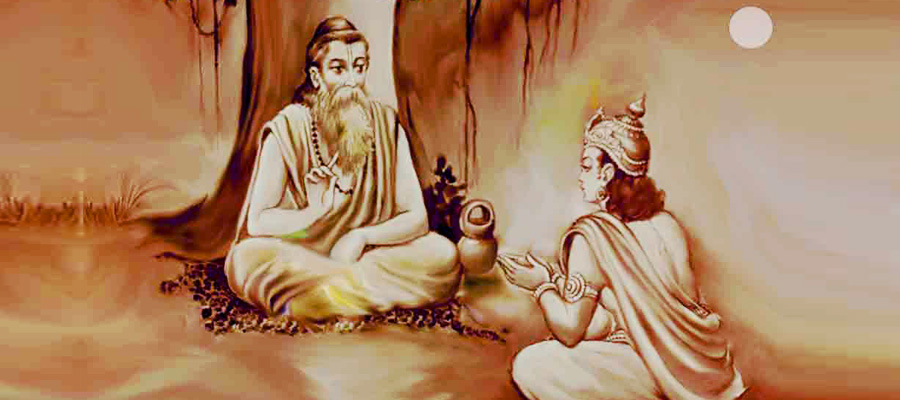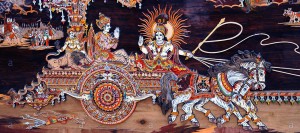The Upaniṣads are ancient texts from India that were composed orally in Sanskrit between about 700 B.C.E. and 300 B.C.E. There are thirteen major Upaniṣads, many of which were likely composed by multiple authors and are comprised of a variety of styles. As part of a larger group of texts, known as the Vedas, the Upaniṣads were composed in a ritual context, yet they mark the beginning of a reasoned inquiry into a number of perennial philosophical questions concerning the nature of being, the nature of the self, the foundation of life, what happens to the self at the time of death, the good life, and ways of interacting with others. As such, the Upaniṣads are often considered to be the fountainhead of the subsequent rich and varied philosophical tradition in India. The Upaniṣads contain some of the oldest discussions about key philosophical terms such as ātman (the self), brahman (ultimate reality), karma, and yoga, as well as saṃsāra (worldly existence), mokṣa (enlightenment), puruṣa (person), and prakṛti (nature)—all of which would continue to be central to the philosophical vocabulary of later traditions. In addition to contributing to the development of a discursive language, the Upaniṣads further frame later philosophical debates by their exploration of a number of means of attaining knowledge, including deduction, comparison, introspection, and debate.
Main Upaniṣads
The Upaniṣads are the fourth and final section of a larger group of texts called the Vedas. There are four different collections of Vedic texts, the Ṛgveda, Yajurveda, Sāmaveda, and Atharvaveda, with each of these collections containing four different layers of textual material: the Saṃhitās, Brāhmaṇas, Āraṇyakas, and Upaniṣads. Although each of these textual layers has a variety of orientations, the Saṃhitās are known to be largely comprised of hymns praising gods and the Brāhmaṇas are mostly concerned with describing and explaining Vedic rituals. The Āraṇyakas and Upaniṣads are also firmly rooted in ritual, but with both groups of texts, there is an increasing emphasis on understanding the meaning of ritual, while some sections of the Upaniṣads seem to move completely away from the ritual setting into naturalistic and philosophical inquiry about the processes of life and death, the workings of the body, and the nature of reality.
The Vedic Upaniṣads are widely recognized as being composed during two chronological stages. The texts of the first period, which would include the Bṛhadāraṇyaka (BU), Chāndogya (CU), Taittirīya (TU), Aitareya (AU) and Kauṣītakī (KsU), are generally dated between 700 and 500 B.C.E., and are considered to predate the emergence of the so-called heterodox traditions, such as the Buddhists, Jains, and Ājīvikas. Scholarly consensus dates the second stage of Vedic Upaniṣads, which includes the Kena (KeU), Kaṭha (KaU), Īśā (IU), Śvetāśvatara (SU), Praśna (PU), Muṇḍaka (MuU), Māṇḍūkya (MaU), and Maitrī (MtU), between 300-100 B.C.E. (Olivelle 1998: 12-13). The older Upaniṣads are primarily composed in prose, while the later ones tend to be in metrical form, but any individual text may contain a diversity of compositional styles. Additionally, many individual Upaniṣads consist of various types of material, including creation myths, interpretations of ritual actions, lineages of teachers and students, magical formulae, procreation rites, and narratives and dialogues about famous teachers, students, and kings.
The so-called Hindu darśanas—Nyāya, Vaiśeṣika, Mīmāṃsā, and Vedānta—do not adhere to the chronology above, as they regard all the Vedic Upaniṣads as śruti, meaning a timeless revealed knowledge. The remaining two Hindu darśanas—Sāṃkhya and Yoga—are usually read as supporting the Vedas. However, when tracing the historical development of philosophical ideas, it is helpful to note some differences in orientation between the two stages of Upanishadic material. While all the Upaniṣads devote considerable attention to topics such as the self (ātman) and ultimate reality (brahman), as well as assume some version of the karma doctrine, the earlier texts tend to characterize ultimate reality in abstract and impersonal ways, while the later Upaniṣads, particularly the Īśā and Śvetāśvatara, are more theistic in orientation. Meanwhile, the later Upaniṣads explicitly address a number of key topics such as yoga, mokṣa, and saṃsāra, all of which would continue to be central aspects of subsequent Indian philosophy.
Minor Upaniṣads
In addition to those affiliated with the Vedas, there are literally hundreds of other texts bearing the name “Upaniṣad.” These texts have been grouped together by scholars according to common themes, such as the Yoga Upaniṣads (Upaniṣads on Yoga), the Saṃnyāsa Upaniṣads (Upaniṣads on Renunciation), the Śaiva Upaniṣads (Upaniṣads on the Hindu God Śiva), and the Vaiṣṇava Upaniṣads (Upaniṣads on the Hindu God Viṣṇu) (see Deussen 1980 and Olivelle 1992). The majority of these texts were composed between the 2nd and 15th centuries CE, although texts referred to as “upaniṣad” have continued to be composed up to the present day. Many of the post-Vedic Upaniṣads further develop core concepts from the Vedic Upaniṣads, such as ātman, brahman, karma, and mokṣa. In addition to a shared conceptual world, the post-Vedic Upaniṣads often quote extensively from the earlier texts and feature many of the same teachers and students, such as Yājñavalkya, Janaka, and Śaunaka.
From Ritual to Philosophy
Despite their significant contribution to subsequent Indian philosophical traditions, there has been disagreement about whether or not the Upaniṣads themselves constitute philosophy. Much of this debate depends, of course, on how one defines philosophy. A recurring argument as to why the Upaniṣads might not be considered philosophy is because they do not contain a unified or a systematic position. This, however, largely reflects the composite and fragmented nature of the texts. Rather than being characterized as unsystematic, the diversity of teachings can be better understood when considering the fact that different texts were composed within the context of separate and often competing scholarly traditions or schools (śākhas). Accordingly, the Upaniṣads do not have a unified philosophical system, but rather contain a number of overlapping themes and mutual interests. Nonetheless, there can be considerable uniformity within a particular text or within a group of texts ascribed to the same school, and even more so according to the lessons ascribed to any particular teacher. In addition to the distinct philosophical agendas of different texts, we see different teachers articulate their teachings within the context of competition over recruiting students, securing patronage, and debating with rivals in public contests. With this context in mind, it is not surprising to find various, sometimes conflicting, teachings throughout the texts.
Due to their connection with previous Vedic material, the Upaniṣads generally assume a ritual context, containing many passages that explain the significance of ritual actions or interpret mantras (sacred verses) uttered during the ritual. One of the most prevalent tendencies to continue from the ritual texts is an attempt to identify the underlying connections (bandhus) that exist among different orders of reality. Often these connections were made among three spheres: the cosmos, the body of the sponsor of the ritual (yajamāna), and the ritual grounds—in other words, between the macrocosm, the microcosm, and the ritual. An illustrative example appears at the beginning of the Bṛhadāraṇyaka Upaniṣad, where the different body parts of the horse in the sacrifice (aśvamedha) are compared to the different elements, regions, and intervals of time in the cosmos (BU 1.1). The implication is that by reflecting on the relational composition of the horse, one can understand the structure of the universe.
There have been some debates regarding the meaning of the word “upaniṣad,” with the components of the word (upa + ni + sad) suggesting texts that were to be learned ‘sitting down near’ one’s teacher. However, the word is not employed in this way in the texts, nor in existing commentaries. Rather, in its earliest textual contexts, the word “upaniṣad” takes on a meaning similar to bandhu, describing a connection between things, often presented in a hierarchical relationship. In these contexts, upaniṣad is often interpreted as the most essential or most fundamental connection. Moreover, “upaniṣad” designates equivalences between components of different realms of reality that were not considered to be observable by the senses, but remained concealed and obscured, and required special knowledge or understanding. On several occasions, “upaniṣad” means ‘secret teaching’ (that is, CU 1.1.10; 1.13.4; 8.8.4; 4.2.1; 5.5.3-4), a notion that is reinforced by the use of other formulations such as guhyā ādeśā (‘hidden instruction’; BU 3.5.2) and para guhya (‘supreme secret’; KaU 3.17; SU 6.22). In the Bṛhadāraṇyaka Upaniṣad, the word “upaniṣad” is equated with the formulation satyasya satyam (BU 2.2.20)—‘the truth behind the truth’— an expression suggesting that an upaniṣad is truth or reality beyond that which appears to be true.
Whether discussing the essence of life or the source of a king’s power, the Upaniṣads show an interest in establishing a firm foundation or an ontological grounding for different aspects of reality, and ultimately, for reality as a whole. One of the terms most associated with these discussions is brahman. The oldest usages of the word are closely connected with the power of speech, with brahman meaning a truthful utterance or powerful statement. In the Upaniṣads, brahman retains this connection with speech, but also comes to refer to the underlying reality or the ontological foundation. In some passages, brahman is associated with the truth (TU 1.1), while on other occasions its is linked with immortality (CU 2.23.1) or characterized as a heavenly abode (BU 4.4.7-8).





